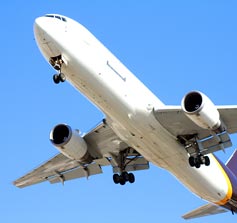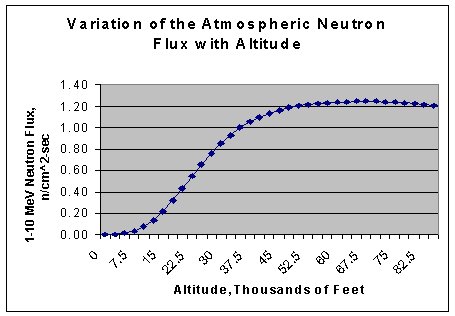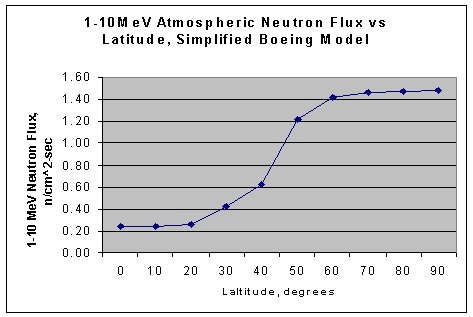
FAA conference presentation July 2007 (Single Event Upset and Effects on Avionics Design)
There is no fee for this presentation given at the 2007 FAA Software and Complex Hardware Conference in New Orleans. This presentation was given to explain the current impact of Single Event Upset on Avionics systems and how the rapid rate of technology change has created an environment where existing design models are inadequate for the range of issues found in the newer generation of semiconductors.
Download PowerPoint Presentation
Download SEU Whitepaper PDF
View Video Presentation
Atmospheric Radiation |
What kind of radiation are we talking about?
Most people when they hear of radiation, think of space craft and satellites or of nuclear weapons. Atmospheric radiation is more closely related to what people think of background radiation. It is radiation that exists in the terrestrial atmosphere from ground level to the upper atmosphere; where we live on the ground and where we fly airplanes. The major sources of this radiation are cosmic rays coming in from deep space and high energy solar particles striking the earth's upper atmosphere. What happens is these high energy particles strike the nucleus of the oxygen and nitrogen atoms in the upper atmosphere. This results in a billiard ball effect that spews out surplus protons and neutrons with neutrons making up the bulk of scattered particles. As the atmosphere gets thicker this cascade of particles increases as it heads down striking more oxygen and nitrogen nuclei, which results in more scattered particles. This billiard ball effect continues and peaks out at an altitude of about 60,000 ft. At this altitude there is a cross over where the thickness of the atmosphere creates a shielding effect that begins to counter the billiard ball effect. This results in a decrease in radiation as we approach the surface of the earth.
So as we go from 60,000 ft where military and some business aircraft fly down to 40,000 ft. we end up with less radiation because of the shielding effect of the atmosphere. The altitude band around 40,000 ft is heavily used by commercial aircraft. At this altitude there is still a significant difference in radiation levels as compared to ground level. Roughly speaking the difference is about 300X.
The variations on this radiation phenomenon are driven by 2 factors that are overlapping. As has just been described, there is a variation caused by the shielding effect of the atmosphere with a peak that occurs at about 60,000 ft. The figure below describes that effect. This is a simple physics aspect where shielding results from atmospheric mass and distance. This effect is fairly uniform because of the physics of the atmosphere.

Another contributing effect is the earth's magnetic effect. The earth's magnetic field shields and alters the pathway of the solar particles that come to our planet. They get redirected more to the poles so there is a lower effect at the equator and a higher impact at the poles. This starts to play into the aspects of commercial flights at high latitudes whether it is northern or southern Polar Regions.

This atmospheric radiation is responsible for causing Single Event Effects (SEE) in electronic components.
What is a Single Event Effect?
Single Event Effect is an issue that impacts both digital and analog components. A single event effect or upset results from a single, energetic particle depositing a charge in a region of a semiconductor device causing it to change state or alter its analog output. The end result is an erroneous output from the device. The types of particles that contribute to this effect are alpha particles, various ions, protons, and neutrons. At sea level, the largest contributors are alpha particles (from packaging and lead), and neutrons. The exposure to all particle types increases as the latitude and altitude increases, especially during solar events.
In airborne applications, the largest single contributor to such occurrences are neutrons. A neutron by definition is a neutral particle, however when it collides with the nucleus of a silicon atom a charged particle is ejected as a result of that collision. This ejected particle then deposits its charge in the surrounding silicon resulting in a Single Event Effect.
In the past the main contributor to these kinds of effects was due to small amounts of radioactive isotopes in the packaging material. But as geometries have shrunk the over riding cause of these effects is atmospheric radiation. So it has been a phenomena transitioning along and evolving with the development of our electronics.
There are many different kinds of Single Event Effects. However, for simplicity they can be reduced to three basic types of events. Single Event Upset (SEU), Single Event Latch Up (SEL) and Single Event Burnout (SEB).
Single event upset (SEU) is a condition that causes corruption of data or logic state in a device resulting in erroneous output. This is a soft error, meaning that data could be updated or corrected or the part reset and normal functionality would be resumed. This was first observed in 1975.
Single event latchup (SEL) is a condition in some CMOS devices where the energy deposited locally in a device by the single particle has turned on parasitic transistors causing high current through the device. In older devices, this usually resulted in the burnout of the component. In newer devices, manufacturers have included current limits in their designs. This SEL usually causes loss of device functionality. In this light it is often referred to as a Single Event Functional Interrupt (SEFI). This can be a persistent failure and can only be cured by cycling power. This was first observed in 1979.
Single event burnout (SEB) is a condition in a high voltage device (voltages of 500 or 600 volts) resulting from the energy deposition by a single particle leading to a feedback mechanism that exceeds the breakdown voltage and therefore destroys the device. SEB of power MOSFETs was first reported in 1986. Single Event Effects can also cause secondary breakdown in bipolar junction transistors (BJTs), resulting in burnout of the transistor as was first reported by Titus et al. in 1991.
Another influence on this issue is the effect of the solar events. Analysis of previous events has shown that there can be significant changes to the atmospheric radiation levels based on solar activity. The effects can be broad with minor events causing a shift of 5-10 X; moderate events with a modifier of 10 - 100 X and very severe (once a century) events resulting in a multiplier of 1,000 X. This is based on the eleven year solar cycle which peaked in 2000 and the next peak is in 2011.

